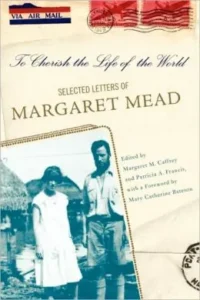Life Is like Blue Jelly: Margaret Mead Discovers the Meaning of Existence in a Dream
INSPIRATIONAL, 18 Mar 2024
Maria Popova | The Marginalian – TRANSCEND Media Service
 The meaning of life has been contemplated by just about every thinking, feeling, breathing human being, and memorably so by a number of cultural icons, including Carl Sagan, Henry Miller, Anaïs Nin, David Foster Wallace, Richard Feynman, and other luminaries. But one of the most unusual and poignant meditations on the eternal question comes, obliquely yet with crystalline precision, from legendary anthropologist Margaret Mead.
The meaning of life has been contemplated by just about every thinking, feeling, breathing human being, and memorably so by a number of cultural icons, including Carl Sagan, Henry Miller, Anaïs Nin, David Foster Wallace, Richard Feynman, and other luminaries. But one of the most unusual and poignant meditations on the eternal question comes, obliquely yet with crystalline precision, from legendary anthropologist Margaret Mead.
In a 1926 letter found in To Cherish the Life of the World: Selected Letters of Margaret Mead (public library) — the same magnificent volume that gave us Mead’s love letters to her lifelong soulmate, Ruth Benedict, and her prescient thoughts on human sexuality — Mead recounts a particularly pause-giving dream. More than a mere record on the unconscious, it unfolds into a powerful metaphor for the meaning of life — for the beauty of not-knowing, for the soul-nourishment of wonder, and for the question of “enough” that Vonnegut once contemplated.
Mead writes:
Last night I had the strangest dream. I was in a laboratory with Dr. Boas and he was talking to me and a group of other people about religion, insisting that life must have a meaning, that man couldn’t live without that. Then he made a mass of jelly-like stuff of the most beautiful blue I had ever seen — and he seemed to be asking us all what to do with it. I remember thinking it was very beautiful but wondering helplessly what it was for. People came and went making absurd suggestions. Somehow Dr. Boas tried to carry them out — but always the people went away angry, or disappointed — and finally after we’d been up all night they had all disappeared and there were just the two of us. He looked at me and said, appealingly “Touch it.” I took some of the astonishingly blue beauty in my hand, and felt with a great thrill that it was living matter. I said “Why it’s life — and that’s enough” — and he looked so pleased that I had found the answer — and said yes “It’s life and that is wonder enough.”
Complement with famous scientists on the art of wonder.
_______________________________________
 My name is Maria Popova — a reader, a wonderer, and a lover of reality who makes sense of the world and herself through the essential inner dialogue that is the act of writing. The Marginalian (which bore the unbearable name Brain Pickings for its first 15 years) is my one-woman labor of love, exploring what it means to live a decent, inspired, substantive life of purpose and gladness. Founded in 2006 as a weekly email to seven friends, eventually brought online and now included in the Library of Congress permanent web archive, it is a record of my own becoming as a person — intellectually, creatively, spiritually, poetically — drawn from my extended marginalia on the search for meaning across literature, science, art, philosophy, and the various other tendrils of human thought and feeling. A private inquiry irradiated by the ultimate question, the great quickening of wonderment that binds us all: What is all this? (More…)
My name is Maria Popova — a reader, a wonderer, and a lover of reality who makes sense of the world and herself through the essential inner dialogue that is the act of writing. The Marginalian (which bore the unbearable name Brain Pickings for its first 15 years) is my one-woman labor of love, exploring what it means to live a decent, inspired, substantive life of purpose and gladness. Founded in 2006 as a weekly email to seven friends, eventually brought online and now included in the Library of Congress permanent web archive, it is a record of my own becoming as a person — intellectually, creatively, spiritually, poetically — drawn from my extended marginalia on the search for meaning across literature, science, art, philosophy, and the various other tendrils of human thought and feeling. A private inquiry irradiated by the ultimate question, the great quickening of wonderment that binds us all: What is all this? (More…)
Go to Original – themarginalian.org
Tags: Inspirational, Philosophy, Wisdom
DISCLAIMER: The statements, views and opinions expressed in pieces republished here are solely those of the authors and do not necessarily represent those of TMS. In accordance with title 17 U.S.C. section 107, this material is distributed without profit to those who have expressed a prior interest in receiving the included information for research and educational purposes. TMS has no affiliation whatsoever with the originator of this article nor is TMS endorsed or sponsored by the originator. “GO TO ORIGINAL” links are provided as a convenience to our readers and allow for verification of authenticity. However, as originating pages are often updated by their originating host sites, the versions posted may not match the versions our readers view when clicking the “GO TO ORIGINAL” links. This site contains copyrighted material the use of which has not always been specifically authorized by the copyright owner. We are making such material available in our efforts to advance understanding of environmental, political, human rights, economic, democracy, scientific, and social justice issues, etc. We believe this constitutes a ‘fair use’ of any such copyrighted material as provided for in section 107 of the US Copyright Law. In accordance with Title 17 U.S.C. Section 107, the material on this site is distributed without profit to those who have expressed a prior interest in receiving the included information for research and educational purposes. For more information go to: http://www.law.cornell.edu/uscode/17/107.shtml. If you wish to use copyrighted material from this site for purposes of your own that go beyond ‘fair use’, you must obtain permission from the copyright owner.
